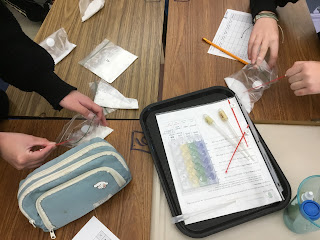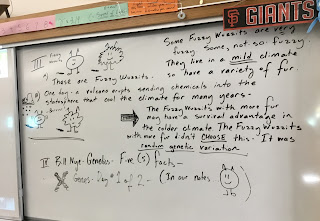Thursday, December 19, 2024
Wednesday, December 18, 2024
Thursday, December 12, 2024
12.12.20204 - Thursday - Notes write-up - Something new. Instead of a video ...
December 12th - Thursday - Science Notes
Viruses, Meiosis, and Genetic Variety.
Yesterday we learned about a virus that “jumped species” in Africa and was able to infect humans, killing about half of the people who contract it. Called “Ebola” (or hemorrhagic fever) it has not turned into a pandemic (like Covid) partly because people who contract it are too ill to travel and spread the disease quickly after becoming infected.
Dr Anthony Faucci, and American scientists and immunologist, was among many doctors who were concerned about a virus that would MUTATE and be easily spread because it would be airborne and have a long INCUBATION PERIOD. Meaning, a person could spread the disease long before they have symptoms. This was the case with COVID - the virus which caused us to go to distance learning in schools, and which caused over one million premature deaths in the United States.
Today we learned a bit about HIV (Human Immunodeficiency Virus) - the virus that causes AIDS. (Acquired Immune Deficiency Syndrome.)
We began the lecture today by asking who has had a cold before and why does a cold not, generally, cause death. In the early 1980’s HIV was identified in the United States. It was first known to have existed in the 1950’s in humans and was probably present in chimpanzees for thousands of years. Likely due to the killing of chimpanzees for food, in Africa, HIV was able to make the species jump into humans.
This was our connection with genetic variety and evolution. Thanks to sexual reproduction and MEIOSIS, GAMETES (cells that are the results of Meiosis) are unique meaning that there are more opportunities for genetic variety in a population that uses sexual reproduction.
Cells that make copies of themselves, like bacteria (most of the time, but not always!) do have genetic variety but they rely on MUTATIONS in the DNA for variety.
The CROSSING OVER that occurs in Meiosis during PROPHASE I means that two people who have children together have the possibility of making billions of combinations of offspring - meaning offspring with a unique genetic makeup. This gives a population in a species variation which means when something changes in the environment (for example, climate, a new virus, a change in food available) the species has a better chance of surviving than if the species relied on ASEXUAL reproduction.
So, even though sexual reproduction may come at the expense of energy when attracting mates or the risk of contracting a sexually transmitted disease, the benefits - for the species as a whole - outweigh the risks. We’ll find that, often, in biology. That if something exists in life there must be a benefit to justify the energy expenditure.
Circling back to viruses; a virus that may be introduced to a population may, initially, cause widespread illness and death. But the genetic variety of the population os a guard against EXTINCTION.
Discussing current events like HIV, COVID, and EBOLA gave us an opportunity to discuss why we are in science class in terms of dispelling myths about the origin of some virus. (We dispelled myths about COVID being purposefully engineered in a laboratory.) it also gave us an opportunity to discuss the prevalence of ignorance and fear that can be replaced with reason and knowledge, as was the case when Ryan White (1971-1990) was disallowed from attending school because of an HIV diagnosis.
* Remember to look up the UPPER CASE terms if you’re unfamiliar with them.
Book recommendation: https://www.amazon.com/Between-Two-Kingdoms-Suleika-Jaouad/dp/0399588582




















































